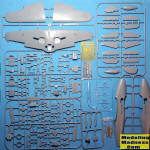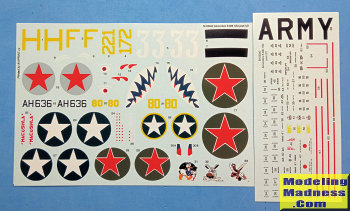
Special Hobby 1/32 P-400 Airacobra
| KIT #: | SH 32062 |
| PRICE: | €40.00 on special offer |
| DECALS: | Four options |
| REVIEWER: | Spiros Pendedekas |
| NOTES: |

| HISTORY |
“P-400” was the designation given to seized examples of P-39 export versions to Great Britain (named Caribou Mk.I and later renamed Airacobra Mk.I by the British), after the Pearl Harbor attack, where the USA, expectedly, had to drastically cut back, if only for a while, military supplies to other countries. Together with the P-39, the P-400 was put to good operational use, among other places, in Africa, the Pacific Theater and, particularly in the USSR, (where some of these machines were delivered under the Lend-Lease act, which was also the place the British delivered machines ended up). The type differed from the classic P-39 in that it featured a 20 mm nose cannon and 12-stub exhausts.
| THE KIT |
 Special Hobby came
in 2007 with their 1/32 P-39D, followed by the Airacobra Mk.I/P-39F and the
P-39Q soon after, then the soviet P-39N/Qs and the 2012 Revell P-39D reboxing.
The latest reissue was the 2015 P-400 edition, which is the subject of this
preview, bought at a discount price from one of the fewer and fewer remaining
hobby shops in Athens. The specific kit came in a quite sizable good quality top
opening box, featuring a very attractive box art of artist Standa Hájek,
depicting an 80 FS, 8 FG F Fighting Rabbit bird over New Guinea.
Special Hobby came
in 2007 with their 1/32 P-39D, followed by the Airacobra Mk.I/P-39F and the
P-39Q soon after, then the soviet P-39N/Qs and the 2012 Revell P-39D reboxing.
The latest reissue was the 2015 P-400 edition, which is the subject of this
preview, bought at a discount price from one of the fewer and fewer remaining
hobby shops in Athens. The specific kit came in a quite sizable good quality top
opening box, featuring a very attractive box art of artist Standa Hájek,
depicting an 80 FS, 8 FG F Fighting Rabbit bird over New Guinea.
Upon opening the box, I was greeted with 144 medium gray styrene parts arranged
in six sprues of various sizes. General shapes of parts look correct, panel
lines are finely recessed, with some panels themselves being nicely raised and
moving surfaces fabric representation looking like in reality. Molding crisp
with minimal flash, with the locating pins at several areas being the icing on
the cake, leaving one wondering if this is a limited run kit or a modern
mainstream one: well done Special Hobby!
Cockpit is well appointed, including all stuff more or less found on the real
thing. The instrument panel features finely raised instrument faces that will
have to be carefully painted. Each entry door is provided as one piece
transparency, with its “non-transparent” part having to be painted. Landing gear
is equally well represented (I would not mind at all if brake lines would have
been molded onto the main legs), with the bays fully boxed and nicely detailed.
The wing root oil cooler ducts are nice and deep. I believe it would be nice for
some PE meshing to be provided, in order to be attached to their ends. All
aerodynamic moving surfaces sans the flaps are separately provided and, not only
look very realistic, but also grant the option for some off-neutral, more
“dynamic” attachment.
The exhausts are of the 12-stub style, which are specific for the kit version
and are beautifully cast in resin. The three blade one piece prop is also very
sharply done, needing only some minor sanding at its leading and trailing edges.
The drop tank looks well shaped, as is the bomb provided (the latter is not
mentioned in the instructions, but I believe it can optionally be attached
underneath).
Transparencies are well molded and crystal clear. Two very nice PE frets are
provided, one of them pre-painted, to cater for various stuff, including seat
belts, cockpit sidewall details, and even exhausts heat shields. Instructions
are wonderful, coming to the form of a 16 page color booklet made from good
quality paper, including a short history of the type, a parts diagram, with the
construction spread in 30 very clear and concise steps, including full color
callouts where applicable. Instructions really shine.
 Four very interesting schemes are provided, for two New Guinean and one Tunisian
U.S. P-400s and for a Russian Airacobra Mk.I. Colors are given in Gunze Sangyo
codes and also in generic form. Decals are superbly printed by Aviprint.
Four very interesting schemes are provided, for two New Guinean and one Tunisian
U.S. P-400s and for a Russian Airacobra Mk.I. Colors are given in Gunze Sangyo
codes and also in generic form. Decals are superbly printed by Aviprint.
Instructions want you to first assemble the cockpit/nose bay group and trap it
between the fuselage half. Putting together the PE belts is a full three step
affair and for a good reason, as the seat belts are composed from no less than
30 PE parts! Attaching the seat and aft radio comes next, followed by the rudder
and tail planes assembly.
Moving to the main wing, you are instructed to attach the main bays, oil cooler
ducts with their lips (expect some challenging fit there) and their exit ones to
the one-piece lower wing half. The top halves can afterwards be glued on,
followed by the ailerons, with the tail planes finally attached to the fuselage.
Landing gear is then attached, followed by the drop tank and air the
radiator/oil cooler exit louvers. The prop is next, followed by assembly and
installation of side doors, gun sight and exhausts. The canopy, pitot tube and
guns are finally affixed, ending a build of average complexity.
| CONCLUSIONS |
This looks by all
means an excellent kit of the iconic Airacobra, featuring correct shapes of
parts, nice engraved panel lines, good detail all around, the key areas
(cockpit, landing gear and so on) included. Molding is crisp, needing minimal
cleanup, transparencies are well done, the exhausts are beautifully cast in
resin and the very comprehensive PE frets promise to beef up the overall looks.
Instructions are second to none and decals look superbly printed. Out of the
box, a very detailed Airacobra can emerge.
Though very close to mainstream, this is an unpretentious limited run kit,
meaning test fitting parts is necessary before joining, however the kit is
definitely buildable and can be uneventfully tackled by even the average modeler
who is willing to test fit and, possibly fill/sand a few parts.
Offered at very sensible (towards low) prices, if you are not a novice and want
a big Airacobra, provided you are comfortable with resin and PE, this really
fine limited run (in nature) kit is as mainstream as it can get, definitely
worth tackling .
Happy Modeling!
March 2023
Copyright ModelingMadness.com. All rights reserved. No reproduction in part or in whole without express permission.
If you would like your product reviewed fairly and fairly quickly, please contact the editor or see other details in the Note to Contributors.